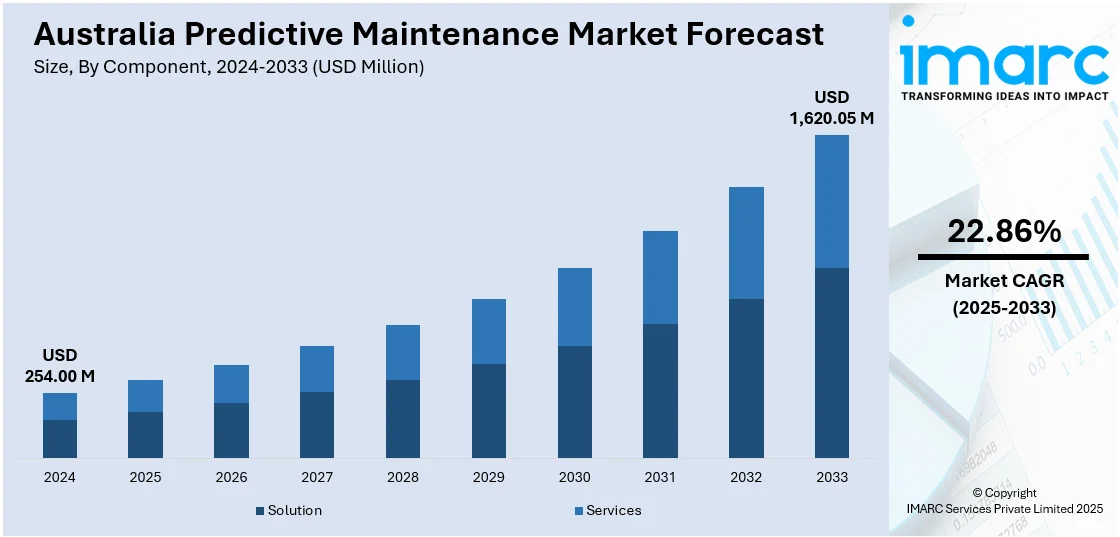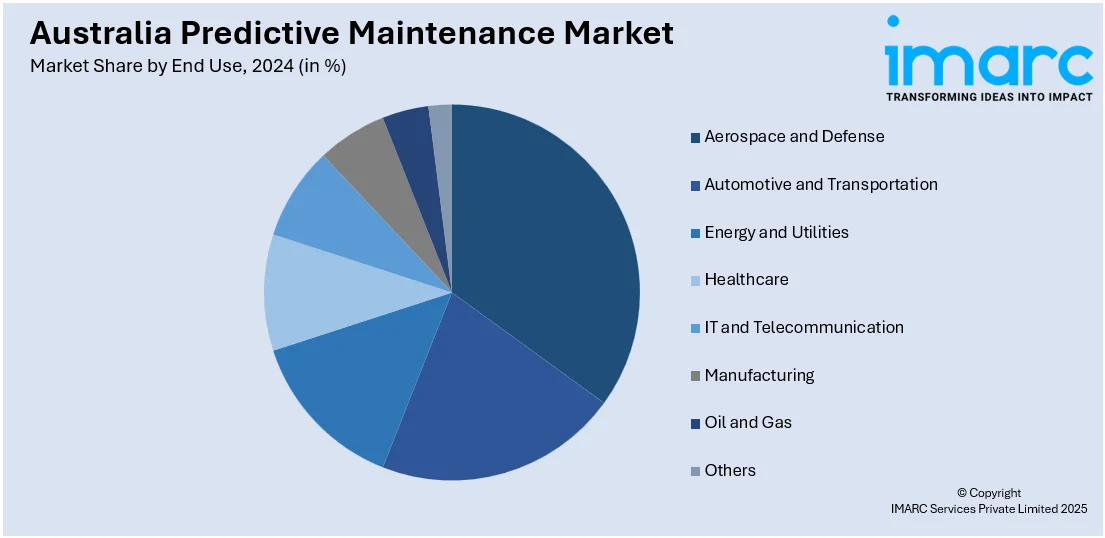
Australia Predictive Maintenance Market Size, Share, Trends and Forecast by Component, Deployment, Enterprise Size, End Use, and Region, 2025-2033
Australia Predictive Maintenance Market Overview:
The Australia predictive maintenance market size reached USD 254.00 Million in 2024. Looking forward, IMARC Group expects the market to reach USD 1,620.05 Million by 2033, exhibiting a growth rate (CAGR) of 22.86% during 2025-2033. As the mining sector is focusing on cost control and efficiency, predictive maintenance tools are in high demand since they aid in extending equipment life and minimizing repair expenses. Besides this, the increasing adoption of the Internet of Things (IoT) is contributing to the expansion of the Australia predictive maintenance market share.
|
Report Attribute
|
Key Statistics
|
|---|---|
|
Base Year
|
2024 |
|
Forecast Years
|
2025-2033
|
|
Historical Years
|
2019-2024
|
| Market Size in 2024 | USD 254.00 Million |
| Market Forecast in 2033 | USD 1,620.05 Million |
| Market Growth Rate 2025-2033 | 22.86% |
Australia Predictive Maintenance Market Trends:
Increasing mining activities
Rising mining activities are offering a favorable market outlook. According to the Australian Bureau of Statistics, in 2024, spending on mineral exploration increased by 1.3%. As mining operations are expanding across the country, companies are facing the challenge of maintaining a wide range of heavy machinery, such as drills, trucks, and conveyors. Predictive maintenance helps address this by using data analytics, sensors, and machine learning (ML) to detect equipment issues before they lead to costly failures. This proactive approach allows mining companies to schedule repairs only when necessary, improving productivity and safety while cutting down on unplanned outages. The harsh working conditions in mines make machinery more prone to wear and tear, further creating the need for timely maintenance solutions. Moreover, as the mining sector continues to focus on cost control and efficiency, predictive maintenance offers a strategic advantage by extending equipment life and minimizing repair expenses. The adoption of Industry 4.0 technologies also plays a key role, as mining companies are investing in smart monitoring systems. This digital shift is driving the demand for predictive maintenance tools that can be assimilated into daily operations.

To get more information on this market, Request Sample
Rising integration of IoT
The increasing incorporation of IoT is impelling the Australia predictive maintenance market growth. IoT devices constantly gather data on performance, temperature, vibration, and other parameters, which helps predict potential failures before they occur. This approach reduces downtime and minimizes maintenance costs for companies. As industries, such as manufacturing and utilities, are adopting IoT technologies, they rely more on predictive maintenance solutions to maintain equipment health and improve operational efficiency. IoT integration allows businesses to analyze large volumes of data using advanced analytics and ML, which leads to more accurate maintenance scheduling. Companies also use IoT-based systems to extend the lifespan of assets and enhance safety standards. In Australia, where industries are operating in remote environments, IoT-supported maintenance solutions provide critical insights without physical inspections. This aids in refining productivity and supporting sustainability goals. As IoT devices are becoming more affordable and accessible, their role in benefiting the predictive maintenance market continues to strengthen across the country. As per industry reports, the Australia IoT market is projected to attain USD 22.98 Billion by 2029, with a CAGR of 10.27%.
Australia Predictive Maintenance Market Segmentation:
IMARC Group provides an analysis of the key trends in each segment of the market, along with forecasts at the country and regional levels for 2025-2033. Our report has categorized the market based on component, deployment, enterprise size, and end use.
Component Insights:
- Solution
- Integrated
- Standalone
- Services
- Deployment / Installation
- Support and Maintenance
- Training and Consulting
The report has provided a detailed breakup and analysis of the market based on the component. This includes solution (integrated and standalone) and services (deployment / installation, support and maintenance, and training and consulting).
Deployment Insights:
- Cloud
- On-Premises
A detailed breakup and analysis of the market based on the deployment have also been provided in the report. This includes cloud and on-premises.
Enterprise Size Insights:
- Small and Medium Enterprises
- Large Enterprise
A detailed breakup and analysis of the market based on the enterprise size have also been provided in the report. This includes small and medium enterprises and large enterprise.
End Use Insights:

- Aerospace and Defense
- Automotive and Transportation
- Energy and Utilities
- Healthcare
- IT and Telecommunication
- Manufacturing
- Oil and Gas
- Others
A detailed breakup and analysis of the market based on the end use have also been provided in the report. This includes aerospace and defense, automotive and transportation, energy and utilities, healthcare, IT and telecommunication, manufacturing, oil and gas, and others.
Regional Insights:
- Australia Capital Territory & New South Wales
- Victoria & Tasmania
- Queensland
- Northern Territory & Southern Australia
- Western Australia
The report has also provided a comprehensive analysis of all the major regional markets, which include Australia Capital Territory & New South Wales, Victoria & Tasmania, Queensland, Northern Territory & Southern Australia, and Western Australia.
Competitive Landscape:
The market research report has also provided a comprehensive analysis of the competitive landscape. Competitive analysis such as market structure, key player positioning, top winning strategies, competitive dashboard, and company evaluation quadrant has been covered in the report. Also, detailed profiles of all major companies have been provided.
Australia Predictive Maintenance Market News:
- In March 2025, Razor Labs, a pioneer in artificial intelligence (AI)-based predictive maintenance technologies, revealed that it planned to conduct a webinar demonstrating how AI sensor fusion aided in revolutionizing predictive maintenance in the Australian mining sector. Participants would discover how to anticipate significant failures and recognize concealed problems that conventional systems overlooked.
- In February 2024, Siemens declared that their ‘Senseye Predictive Maintenance Software’ featured generative AI capabilities. This improvement sought to make predictive maintenance more engaging and user-friendly, offering a solid and all-encompassing solution that utilized the advantages of established ML techniques and generative AI. BlueScope Steel, the well-known Australian steel producer, was among the first to embrace this technology.
Australia Predictive Maintenance Market Report Coverage:
| Report Features | Details |
|---|---|
| Base Year of the Analysis | 2024 |
| Historical Period | 2019-2024 |
| Forecast Period | 2025-2033 |
| Units | Million USD |
| Scope of the Report |
Exploration of Historical Trends and Market Outlook, Industry Catalysts and Challenges, Segment-Wise Historical and Future Market Assessment:
|
| Components Covered |
|
| Deployments Covered | Cloud, On-Premises |
| Enterprise Sizes Covered | Small and Medium Enterprises, Large Enterprise |
| End Users Covered | Aerospace and Defense, Automotive and Transportation, Energy and Utilities, Healthcare, IT and Telecommunication, Manufacturing, Oil and Gas, Others |
| Regions Covered | Australia Capital Territory & New South Wales, Victoria & Tasmania, Queensland, Northern Territory & Southern Australia, Western Australia |
| Customization Scope | 10% Free Customization |
| Post-Sale Analyst Support | 10-12 Weeks |
| Delivery Format | PDF and Excel through Email (We can also provide the editable version of the report in PPT/Word format on special request) |
Key Questions Answered in This Report:
- How has the Australia predictive maintenance market performed so far and how will it perform in the coming years?
- What is the breakup of the Australia predictive maintenance market on the basis of component?
- What is the breakup of the Australia predictive maintenance market on the basis of deployment?
- What is the breakup of the Australia predictive maintenance market on the basis of enterprise size?
- What is the breakup of the Australia predictive maintenance market on the basis of end use?
- What is the breakup of the Australia predictive maintenance market on the basis of region?
- What are the various stages in the value chain of the Australia predictive maintenance market?
- What are the key driving factors and challenges in the Australia predictive maintenance market?
- What is the structure of the Australia predictive maintenance market and who are the key players?
- What is the degree of competition in the Australia predictive maintenance market?
Key Benefits for Stakeholders:
- IMARC’s industry report offers a comprehensive quantitative analysis of various market segments, historical and current market trends, market forecasts, and dynamics of the Australia predictive maintenance market from 2019-2033.
- The research report provides the latest information on the market drivers, challenges, and opportunities in the Australia predictive maintenance market.
- Porter's five forces analysis assist stakeholders in assessing the impact of new entrants, competitive rivalry, supplier power, buyer power, and the threat of substitution. It helps stakeholders to analyze the level of competition within the Australia predictive maintenance industry and its attractiveness.
- Competitive landscape allows stakeholders to understand their competitive environment and provides an insight into the current positions of key players in the market.
Need more help?
- Speak to our experienced analysts for insights on the current market scenarios.
- Include additional segments and countries to customize the report as per your requirement.
- Gain an unparalleled competitive advantage in your domain by understanding how to utilize the report and positively impacting your operations and revenue.
- For further assistance, please connect with our analysts.
 Request Customization
Request Customization
 Speak to an Analyst
Speak to an Analyst
 Request Brochure
Request Brochure
 Inquire Before Buying
Inquire Before Buying




.webp)




.webp)












